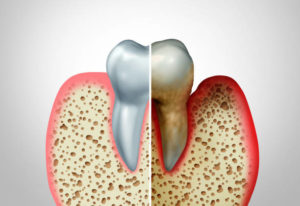 Your teeth aren’t the only component of a healthy smile. Your gums are equally important. Healthy gums can be pink, light pink, black, or brown. They are firm and resilient, so they shouldn’t move when you touch them or bleed after brushing and flossing. If your gums are spongy or feel soft, it can be a symptom of gum disease. The bacterial infection is a leading cause of tooth loss and is linked to various health conditions. If you notice changes to the color or texture of your gums, here’s why you should schedule an appointment with your dentist right away.
Your teeth aren’t the only component of a healthy smile. Your gums are equally important. Healthy gums can be pink, light pink, black, or brown. They are firm and resilient, so they shouldn’t move when you touch them or bleed after brushing and flossing. If your gums are spongy or feel soft, it can be a symptom of gum disease. The bacterial infection is a leading cause of tooth loss and is linked to various health conditions. If you notice changes to the color or texture of your gums, here’s why you should schedule an appointment with your dentist right away.
What Causes Spongy or Bleeding Gums?
Your gums can bleed or feel spongy for many reasons, like brushing or flossing too aggressively, but they can also be signs of an infection. According to the Centers for Disease Control and Prevention, 50% of adults have a form of the oral infection. It’s caused by bacteria found in plaque and tartar buildup from improper oral hygiene habits.
Risks of Gum Disease
Initially, the symptoms of gum disease may not be alarming. You might attribute red, swollen, or bleeding gums to pushing too hard when brushing or flossing, but they are signs of gingivitis, the earliest stage of the infection. A deep cleaning and changes to your oral hygiene routine can treat the infection.
However, with no treatment, gingivitis will progress to periodontitis, which can destroy the supporting structures of your teeth, including your jawbone. Over time, your teeth can loosen and fall out.
Bacteria from the infection can also enter your bloodstream. As it circulates throughout your body, it can cause chronic inflammation. It is also connected to an increased risk of many health conditions, like heart attacks, Alzheimer’s disease, respiratory illness, and diabetic complications. There’s also a link between gum disease and preterm delivery and low birth weights.
It’s best to contact your dentist at the first sign of gingivitis. Your dentist will get you into the office quickly to examine your mouth. They’ll create a personalized strategy to stop the infection in its tracks.
Preventing Gum Disease
Although gum disease is common, it’s preventable. You can invest in a healthy mouth and body by brushing your teeth at least twice daily for 2 minutes. Commit to flossing your teeth every day to remove food debris and plaque missed by brushing. Use an antimicrobial mouthwash to kill any bacteria hiding in your mouth.
Besides caring for your teeth and gums at home, visit your dentist every 6 months for a cleaning and checkup. Routine dental care stops common issues from occurring in the first place to ensure your teeth last for a lifetime.
About Dr. Les Latner
Dr. Latner earned his dental degree from the Washington University School of Dental Medicine and has regularly continued his education in many specialties, including cosmetic dentistry, pediatric dentistry, and general dentistry. He is affiliated with many professional organizations, including the American Dental Association. Request an appointment through his website or call (310) 907-7987.

